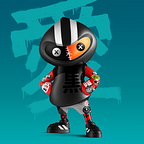After finding an NFT project that you’re interested in, the next steps is usually to join their Discord server and verify yourself before getting access to the different channels available.
There would be several terms that you might be trying to make sense of and here’s the top 15 (maybe more like 20) phrases that is commonly used to easy your chatting journey:
- GM / GN
“GM” or “GN” is simply short for ‘good morning’ or ‘good night’. This is self-explanatory. - GMI / WAGMI / NGMI
“GMI” is the short form for ‘gonna make it’, “WAGMI” for ‘we’re all going to make it’ and “NGMI” for ‘not going to make it’. These terms are used to describe if the user or project is able to achieve what they were going to be doing. - LFG
“LFG” is the acronym for ‘let’s fucking go’ and is used in excitement about new project launched or if the user/project is going to pull off the feats that they mentioned. - To the moon
It’s a general term that’s often used in the NFT/Crypto space which refers to an asset’s value increasing by leaps and bounds crazily. There’s no clear definition that represents the percentage/value of the gains, but a 20% increase in value certainly won’t be classified as ‘mooning’ for people who saw Dogecoin’s price climbing about 9,500% in 12 months. - Diamond/Paper hands
A person with ‘diamond hands’ is a person who holds on to an asset through price volatility, poor market sentiment, and whatever kind of negative news of vibes that the community is generating. On the contrary, ‘paper hands’ is basically the opposite that refers to someone who sells something, at what is perceived by others as too low of a price. - Whale
A ‘whale’ is basically someone with a lot of money to invest or owns a lot of high-value NFT/crypto projects. - Mint
This term refers to buying a completely new NFT directly from the creator or project’s website. ‘Minting’ is the process of creating that NFT on the blockchain and bringing it into your wallet. - Gas
The price for making a transaction on a blockchain is called ‘gas’. When buying NFTs on a blockchain like Ethereum or Solana, you’ll need to pay for the network/transaction fees and the cost depends on the activity on the network - low activity equals low fees and high activity equals high fees. - Reveal
This term is usually shows up on the chats after minting a new project where the NFT content isn’t available and you are waiting to view what you have minted. An example of how this term is commonly used on is “When is the reveal date?”. - Floor
It represents the lowest price available for an asset in the NFT collection and is the minimum amount you need to buy an asset from the project on the secondary marketplace. - Sweeping the floor
Similarly to how we use a broom for cleaning — “Sweeping the floor” refers to a whale or group of people who are buying assets in an NFT project that is listed at floor price to increase the minimum value of the project. - Snapshot
A “snapshot” refers to a check at a certain point in time. This is usually done to determine who’s eligible for the rewards of the NFT project. - Airdrop
An “airdrop” refers to an action where a specific cryptocurrency or a new NFT is being dropped into your wallet for free. This is a popular way for projects to reward their community or users. - Burn
This an action term that means ‘to destroy’. An example would be if only 2,000 NFTs are sold in a collection that was intended to consist of 8,000 — the team may decide to ‘burn’ the remaining 6,000 to make its collection more exclusive. - FUD/Rugpull
These are the phase we definitely do not like to see often. “FUD” is the term used for ‘Fear’, ‘Uncertainty’, and ‘Doubt’. It is often used to describe negative news stories or vibes that are either inaccurate or completely false. As for the term “rugpull”, it refers to a scam where people behind the project disappears with all the money immediately after launch. We still do get an actual NFT in return for what we paid for, but it’s most likely not worth much and might not even have any value on the secondary marketplace.
Gaining a quick understanding of these NFT terms would allow you to easily respond to the chats without looking like a total newbie in the space. Let us know if there are any other terms that you’ve came across and would like to share it with others!
